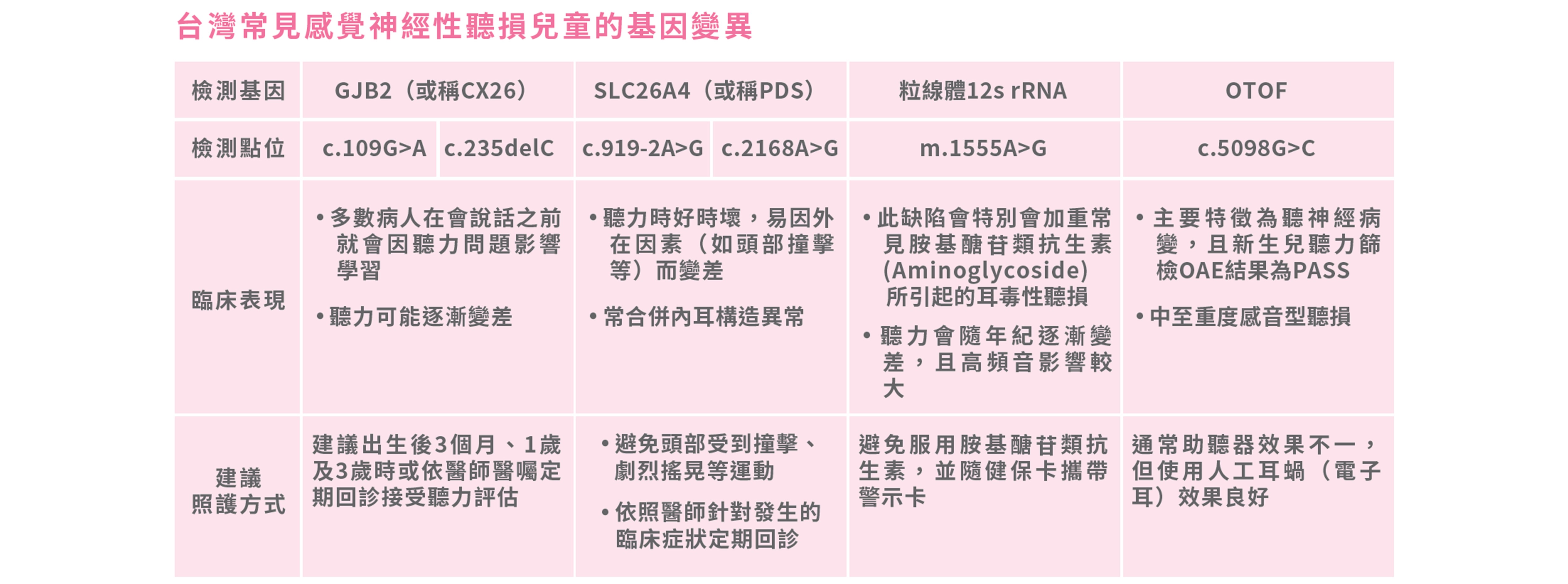感覺神經性聽損基因檢測
服務介紹
根據衛生署新生兒篩檢統計,各項新生兒先天性異常疾病發生率不一,其中新生兒聽損佔有相當比例,新生兒父母不得不重視。 慧智基因提供《新生兒感覺神經性聽損基因檢測》,只要在新生兒篩檢採血的同時,多採集幾滴腳跟血液置於血片上,就能進行檢查。
■ 感覺神經性聽損
先天性聽力障礙可分為傳導性聽損和感覺神經性聽損,傳導性聽損是由外耳或中耳的缺陷所造成,阻礙了聲音的傳導;感覺神經性則是因為內耳或神經路徑的感覺系統發生問題所造成。
全台灣每年都有600-2,000個新生兒患有先天性感覺神經性聽損(3‰-1%),其中超過90%都是由聽力正常的父母親所生,如果因為未及早發現而沒有積極地追蹤治療,關鍵幼兒學語期缺乏聲音刺激將影響寶寶的語言學習、認知、溝通和社交互動發展。其中2/3的感覺神經性聽損患兒可以歸咎於基因遺傳因素。

隨著醫療科技的進步,基因檢測已成為現今臨床上評估的有力工具,診斷結果可以幫助醫師和父母了解實際致病機轉,有效預測不同照護或手術方式所帶來的治療效果,依據突變基因不同採取不同的預防措施,以免聽力持續惡化,早期診斷,早期療育,把握寶寶語言學習黃金期,藉由遺傳諮詢及胚胎著床前單基因檢測(PGT-M)防止再生下聽損寶寶。
檢測說明
嬰幼兒的聽力發展與語言學習密不可分,有些小朋友語言發展遲緩,是因為聽力障礙所導致,如果能把握出生至6個月前的聽力矯正黃金期,對寶寶語言學習會有很大的幫助。
以前,新生兒聽損難以早期診斷,臨床上重度聽損被診斷出來的年紀約在1.5歲;中、輕度聽損診斷則在3.5-4歲間,都已錯過聽力矯正關鍵期,會影響後續身心、智能和社會適應能力的發展。現在透過新生兒聽力篩檢和新生兒聽損基因篩檢已大幅提高檢出率,國內外小兒科醫師及耳鼻喉科醫師也均肯定新生兒應及早接受『聽力篩檢』。

選擇新生兒聽損基因篩檢搭配政府補助之新生兒聽力篩檢,可以進一步檢視過去無法第一時間被發現的輕微聽損、晚發型聽損、藥毒性聽損及聽神經病變,並有效選擇最適切的治療及照護方法,給寶寶最全面的健康防護。

適用對象
✔ 已確認聽損之患者
✔ 有聽損家族史之個案
檢測流程

其他說明
個案分享
弟弟(化名)出生時接受聽損基因檢查,發現聽力檢測一切正常的他居然帶有藥毒性聽損的異常基因,若不慎使用特定抗生素會造成不可逆的聽力惡化。醫師特別提醒爸媽,若日後感冒或其他疾病看診時務必事先告知醫師,避免使用胺基醣苷類藥物,以免造成遺憾發生。而此基因為母系遺傳,媽媽這也才了解為什麼家族中曾出現不明原因後天失聰的親戚,事後再去檢查果然是同一個基因異常。如果當時他們可以早一點知道自己對藥物的特別反應,就可以完全避免聽力惡化發生。
